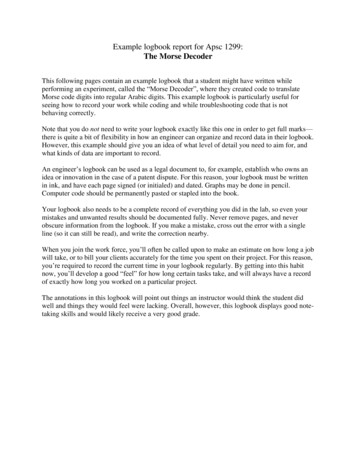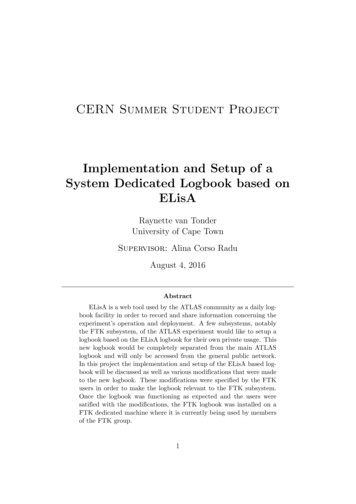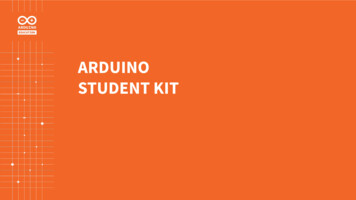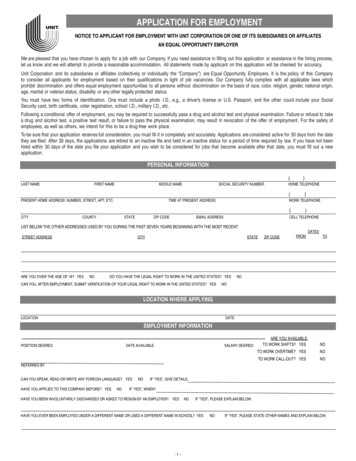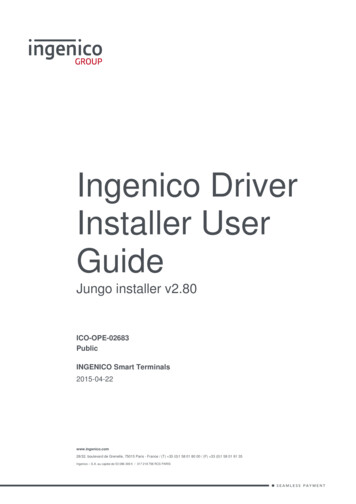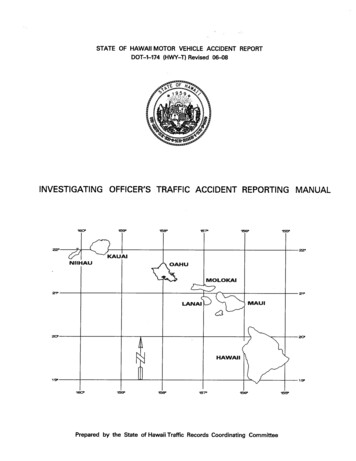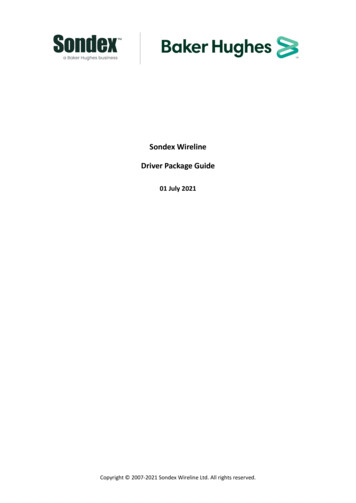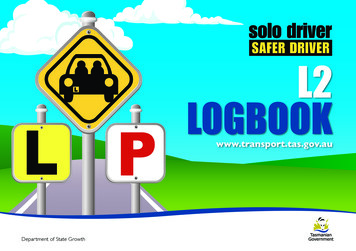
Transcription
L2LOGBOOKwww.transport.tas.gov.auDepartment of State Growth
This logbook is owned and maintained by the Department of State Growth.Any requests to reproduce information contained in it must be made in writing to the Registrar ofMotor Vehicles c/- the Department of State Growth.This logbook is produced by the Department as a guide for people learning to drive.While every effort has been made to ensure that the information is accurate and conforms toTasmanian legislation, this book must not be construed as a legal interpretation of legislation.From time to time the Department may provide more up to date information on the internet that maydiffer from the information presented in this publication.All enquiries about this logbook should be directed to:1300 13 55 13 orThe Department of State GrowthGPO Box 1002 Hobart Tasmania 7001L2 LOGBOOK - Includes Compulsory Logbook for L2 learnersMR 94 - Version 9 - September 2019
THIS BOOK INCLUDES THE COMPULSORY LOGBOOK FOR L2 LEARNERS.ONLY FILL IN THE LOGBOOK ONCE YOU HAVE PASSED YOUR L2 PRACTICALDRIVING ASSESSMENT AND MOVED TO YOUR L2 LICENCE.THIS LOGBOOK BELONGS TO:NAME:LEARNER LICENCE NO:CONTACT DETAILS:Address:Phone:If found, this book should be returned to the person above or to the Registrar of Motor Vehicles, GPO Box 1002, Hobar t, Tasmania, 7001.L2 LOGBOOK - Includes Compulsory Logbook for L2 learners - 1
CONTENTSLEARNING TO DRIVE IN L2What you have to doL2 driving skillsWhat are higher order skills?How to develop these skillsWhen will I be ready to move to myPs and drive solo?THE P1 PRACTICAL DRIVINGASSESSMENT (P1 PDA)About the P1 PDAAssessment itemsHow to book your assessmentHow to mark the practice Hazard IdentificationexerciseWhat to bring to your assessmentYOUR LOGBOOKWhy use this logbook?Recommended driving tasksHOW TO USE THE LOGBOOKFilling in the 50 hoursCompleting the recommended tasksBefore your P1 PDAQuestion and Answers2 - L2 LOGBOOK - Includes Compulsory Logbook for L2 learners333455667911111212121212131415PRACTISING THE DRIVING TASKSCity drivingDriving in heavy trafficOpen roads/highwaysCountry drivingUnsealed roadsDawn/dusk drivingNight drivingWet weatherTracking your 283054
LEARNING TO DRIVE IN L2Now that you’ve passed the L2 Practical Driving Assessment (L2 PDA)and shown that your car control skills are becoming automatic, you’reready to continue developing higher order driving skills.What you have to doL2 driving skillsDuring L2 you’ll continue to develop higher order driving skills. Theseare the driving skills that you can only learn from getting a lot of drivingexperience in different traffic, road and weather conditions. They takea long time to develop, so drivers with a lot of experience have betterhigher order skills.You must:»» Go to a Service Tasmania shop and be issued with an L2 licence.»» carry your learner licence when driving»» be supervised by a full Australian car licence holder who has»» no periods of licence suspension or disqualification in the previous2 years»» a blood alcohol content of less than .05 while supervising»» display L plates so that they are clearly visible from the front andback of the car you are driving.»» have a zero blood alcohol content»» complete at least 50 hours and the 8 recommended driving tasks inthis book»» hold your licence at L2 for at least 9 continuous months»» not tow another vehicle»» not drive faster than 90 km/h in 90 km/h zone, 90 km/h in 100 km/hzone or 100 km/h in 110 km/h zone.L2 LOGBOOK - Includes Compulsory Logbook for L2 learners - 3
What are higher order skills?Perceptual skillsWHAT IS IT?WHY IS IT IMPORTANT?Your ability to see everything around you,and judge speed and distance.You always need to:»» l ook around at the whole driving scene – as far ahead aspossible, behind you, to the sides and right in front of you(this is called “scanning”)»» be able to judge the distance and speed of other road users,to help you select safe gaps for turning, and maintain a safefollowing distance.Hazard perceptionYour ability to recognise things around you thatmight be a threat to your safety.You always need to respond appropriately to your drivingenvironment. Good perceptual skills and spare attention helpyou recognise hazards in plenty of time and give you enoughtime to respond to them.Decision makingYour ability to make safe, quick driving decisions.You’re always making decisions:»» some are almost automatic (like deciding where to park orwhen to change lanes)»» others require more attention (like responding to a hazard).Self-improvementYour ability to think about your own driving.Safe drivers notice their mistakes and know how to fix them.Good self-improvement skills help you to learn safely whenyou drive on your own.Spare attentionYour ability to display automated driving skillsand see and react to your driving environment.Spare attention is when you are able to have a higher levelof attention to concentrate on a variety of driving tasks atthe same time.4 - L2 LOGBOOK - Includes Compulsory Logbook for L2 learners
How to develop these skillsThere’s no easy way to get higher order skills. You need to get moredriving experience and practice. You must complete at least 50 hoursdriving practice on your L2 licence, as that’s considered the minimumamount of time you need to star t developing these higher orderdriving skills.During L2, star t challenging yourself by experiencing new situationsand conditions. This can include highway merges and driving, hazardidentification and response and under taking more complex drivingmanoeuvres. The recommended tasks in the logbook (pages 1926) can give you some ideas on things to try. Getting experience indifferent driving conditions helps you develop higher order driving skills.Units 4, 5 and 6 of the Driver Competency Standard are also a goodway to check your progress in learning to drive. They can help you andyour supervisor by giving you an outline of the things you should belearning during L2. See the full Driver Competency Standard onwww.transpor t.tas.gov.au for more information.When you’ve been driving for a while, it’s impor tant to refreshyour knowledge of the road rules. A good understanding of theroad rules is an essential par t of driving. Rules can change over time,so it’s impor tant to keep up with the road rules throughout yourdriving career. You can sit the practice driver knowlegdge at any timeby visiting www.transpor t.tas.gov.au/drkts.When will I be ready to move to my Psand drive solo?If you’re ready to go for your P1 Practical Driving Assessment(P1 PDA), you:»» a djust your speed and position on the road to suit theconditions or situation»» d rive in a way that allows you to deal with other road users(maintain a safe following distance, position your car so that you cansee well, predict what other road users are doing)»» m ake safe driving decisions (like slowing down and being cautious innew driving situations, or reducing distractions in the car)»» obey all road rules when driving»» a re able to identify hazards around you and continue safe drivingpractices»» a fter making a mistake, get your driving back to normal (this meansyou must recognise that you have made a mistake and how itchanged your driving)»» d on’t compare yourself with others (don’t judge yourself againstother drivers - this can make you overconfident and you may beginthinking you’re a better driver than you are)»» w atch how other road users behave, and think about why theybehave this way (a driver who makes a gap to let you into trafficis being cour teous; if you add some of that cour tesy to your owndriving, you will gain something from it, and so will other drivers)»» w hen you see another driver make a mistake, remember it so thatyou can avoid making that mistake in the future»» s how by the way you drive that you know you are at least partlyresponsible for any driving incident (anything that you would prefernot to happen) that happens to you»» don’t let your emotions interfere with safe driving»» a void repeating unacceptable risks (an unacceptable risk is one thatcould have a result that you would be unhappy about).L2 LOGBOOK - Includes Compulsory Logbook for L2 learners - 5
THE P1 PRACTICAL DRIVINGASSESSMENT (P1 PDA)About the P1 PDAIn the P1 PDA you’ll have to:1. Follow directionsTo move from L2 to your provisional licence you need to passthe P1 PDA.»» d rive where your Driving Assessor tells you (e.g. “at the nextintersection, turn right”)You can take the P1 PDA when you:»» d o what the Driving Assessor tells you (“identify hazards andtell me what you see on your right, left, ahead, behind andoncoming”)»» are 17 years or older»» have held your learner licence at L2 for at least9 continuous months»» h ave completed the L2 logbook, including the MINIMUM50 hours (3000 minutes) driving experience and the recommendeddriving tasks.The P1 PDA:»» u nder take a highway merge and drive when your DrivingAssessor tells you.This helps your Driving Assessor find out how well:»» you have automated your driving skills»» you notice and fix your mistakes»» you identify and respond to hazards around you.»» l ooks at how well you use your car controls withoutthinking about them2. Do driving exercises»» l ooks at how well you’re developing higher order driving skills(such as decision making, scanning and identifying andresponding to hazards) and»» Your Driving Assessor will ask you to identify the hazards that you seeon your left, right, ahead, behind and oncoming while you continuesafe and legal driving»» checks whether you’re ready to star t driving on your own.Learn to Drive videos are available on the Transpor t Website:www.transpor t.tas.gov.au/licensing/learning to driveWe want you to be prepared - only go for your P1driving assessment when you’re sure that you’re ready,otherwise you’ll have to pay again.6 - L2 LOGBOOK - Includes Compulsory Logbook for L2 learners»» Y our Driving Assessor will ask you to merge onto a highway andmaintain safe and legal driving on that highway»» Y our Driving Assessor will ask you to undertake a driving exercisewhich may be one of the following:»» “ Left something behind” this involves you finding the first suitablespot to turn your vehicle (without driving around the block) anddrive back to the place you stopped and park again»» “ Visit a friend” this involves you finding a spot to turn aroundand then to park outside a house up the street belonging toyour friend.
The driving assessment is split into six sections and looks like nsDrivingexerciseBy using the assessment items below, the Driving Assessor willlook at how well you:»» drive your car»» put the road rules into practice»» do manoeuvres»» notice and fix your mistakes»» identify and respond to hazards around you»» make decisions when driving.Assessment ItemsFlowTo meet the standard on flow, you must:»» Start the vehicle and move off without delay»» P repare for a manoeuvre by monitoring traffic and obeying roadmarkings and road signs»» S elect an appropriate location and gap in traffic to perform amanoeuvre»» Start each manoeuvre promptly»» J oin parts of the manoeuvre together and link manoeuvres togethersmoothlyFollowdirectionsHighway driveFollow directionsHazardidentification»» Stop and remain stopped until it’s time to proceed. If there is a gapsafe for a manoeuvre, you maintain a continuous flow and don’t cometo a stop unnecessarily»» Obey the road rules»» Drive without assistance where appropriatePathTo meet the standard on path, you must:»» Choose the best path on the road and maintain it during manoeuvres, turnsand curves»» Respond quickly to deviations from the ideal path»» Adjust the path to suit the situation»» Approach parking and U-turn manoeuvres in a way that allows them to becompleted smoothly and finish in the correct position (P1 only)»» S elect the most suitable location to perform a manoeuvre, where it makessensible use of space and minimises the delay to other road users and the timespent on the wrong side of the road»» U se the most travelled section of the road, including driving in the centre ofmarked lanes»» Maintain a legal path.»» F it in with traffic flow, including driving at a speed that would allowother traffic to travel at a safe and reasonable speedL2 LOGBOOK - Includes Compulsory Logbook for L2 learners - 7
ResponsivenessTo meet the standard on responsiveness, you must:»» Drive at a speed that would allow you to avoid hazards that couldbe expected in that area»» Adjust your speed appropriately as you approach new or changingdriving environments»» Adjustments are timely and at a frequency consistent with theenvironment»» Position the car suitably for the environment»» Respond appropriately to hazards posing a real or potential threat»» Ease off the accelerator for an appropriate duration before a knownhazard and cover the brake when necessary»» A ccelerate if moving away from the hazard will achieve a saferoutcomeMovementTo meet the standard on movement, you must:»» Make sure each car movement is in the right direction, and the cardoesn’t move more than 30cm in the wrong direction»» Drive the car so that it starts moving or changes speed smoothly»» Brake so that the car comes to a smooth stop»» Brake mainly in a straight line and vary brake pressure according tothe road surface»» Travel within the speed limit, but not too quickly or unreasonablyslowly for the conditions»» Maintain an appropriate following distance8 - L2 LOGBOOK - Includes Compulsory Logbook for L2 learners»» Stop accurately, safely, legally and remain stopped as requiredLookTo meet the standard on look, you must:»» L ook in the appropriate direction before moving off, turning ordiverging and any other situation that requires it»» L ook in appropriate direction again if there has been a significantpause since previous look»» Ensure your head and eye movements match the situation and allowyou time to respond safely to your environment»» Check mirrors often enough to remain aware offollowing traffic»» Check mirrors before braking»» Look at appropriate mirror(s) before moving off, turning or divergingand any other situation that requires itSignalTo meet the standard on signal, you must:»» Use the correct indicator for an appropriate duration before movingoff, turning or diverging»» Ensure indicator is turned off after manoeuvre is completed»» Reapply the indicator if it self-cancels before a manoeuvre iscompleted
Hazard IdentificationTo meet the standard on hazard identification,you must:Vehicle managementTo meet the standard on vehicle management,you must:»» Ensure the cabin and occupants are safeDescribe all hazards on your left, right, ahead, behindand oncoming. Hazards include:»» Adjust the mirrors for the best view of traffic»» pedestrians (from the left, right, ahead or behind)»» Respond to appropriate warning lights»» other motor vehicles (from the left, right, ahead, behind oroncoming)»» Use required controls, switches and pedals correctly»» other road users such as cyclists (to the left, right, ahead, behindor oncoming)»» Adopt and maintain an effective driving posture»» Steer and use gears in a way that demonstrateseffective control»» details of the environment such as intersections, lights, roadsigns, road conditions (left, right and ahead).Hazards, for the purpose of the driving assessmentswill generally not include:»» static objects such as protruding trees and parked vehicleswithout occupants»» pedestrians walking away from the intended path of yourvehicle, or»» v ehicles that have cleared the intersection before you arrivethere.Remember – PRACTISE PRACTISE PRACTISE.Ask your supervisor to design a P1 practicedriving assessment. Your supervisor can use theassessment items (pages 7-9) and the practiceassessment form (page 10) to see how you went.How to book your assessmentGo to a Service Tasmania shop with your learner licence, you will needto pay the P1 PDA fee. orPay and book online at www.transpor t.tas.gov.au/online.L2 LOGBOOK - Includes Compulsory Logbook for L2 learners - 9
P1 PRACTICE ASSESSMENT FORMSection 1Follow Directions to Exercise ASection 2Exercise ASection 3Follow Directions to Exercise BSection 4Exercise BSection 5Follow Directions(highway drive) to Exercise CFollow Directions(including hazard identification exercise) toyour star ting pointSection 6LSFMPVMRHIPedestriansLR A BVehiclesL R A B OOtherL R A B OL LookS SignalF FlowHI Hazard IdentificationL LeftB BehindM MovementP PathR ResponsivenessVM Vehicle ManagementR RightO OncomingA AheadIt is important to remember that your supervisory driver is not a trained Driving Assessor so your practice assessmentmay not be exactly the same as your actual assessment.10 - L2 LOGBOOK - Includes Compulsory Logbook for L2 learners
How to mark the practice HazardIdentification exerciseWhat to bring to your assessmentThe hazard identification exercise is marked over 2 intersections.Ask your supervisory driver to detect and circle the hazards theywould expect an experienced L2 licence holder to see.»» A suitable car (see L1 Logbook, page 27 for the SuitableCar rLRABOL LeftR RightA AheadB BehindO OtherNow as you continue to drive you must verbalise the hazards to yoursupervisory driver, who will cross them off.»» Your learner licence»» Your completed logbook:»» s howing that you’ve completed at least 50 hours on road drivingexperience during L2»» with the declaration signed by you and your supervisor(s)»» Y our driving assessment confirmation sheet and receipt (which you’llget when you book your assessment).Remember – everyone learns differently, andyou may take longer than 50 hours before you’reready to take your P1 PDA.The more practice you do the safer you will bewhen driving Hazards are anything onor near the road that is orcould become a danger ora problem for safe driving,see (page 9) for list ofhazards.Remember – You need to make sure your drivingstays safe and legal while detecting hazards.L2 LOGBOOK - Includes Compulsory Logbook for L2 learners - 11
YOUR LOGBOOKYour logbook is the official record of your progress in learning to drive– keep it safe and secure.Why use this logbook?As an L2 car learner you must have at least 50 hours on-road drivingexperience before taking your P1 Practical Driving Assessment. It isrecommended that you also complete the 8 driving tasks that involvedriving in different weather and road conditions. These hours and tasksmust be recorded in this logbook. You must take it to your P1 PDA.Recommended driving tasksNow that you’ve been driving for a while, it’s impor tant that youexperience some different driving conditions, so you’re familiar withthem when you star t driving on your own.Make sure you practise the recommended tasks enough so that youcan do them comfor tably without making mistakes.HOW TO USE THE LOGBOOKFilling in the 50 hours1. In each row you must fill in:›the date› the time that you star ted and finished› how many minutes you drove for› where you star ted driving and where you finished›the number of kilometres you drove*12 - L2 LOGBOOK - Includes Compulsory Logbook for L2 learners›the car’s registration number›your signature› you may choose to fill in the type of road, visibility,road and traffic conditions.* Check the car’s odometer when you begin and finish driving, and takeaway the beginning number from the finishing number to work outthe number of kilometres you drove.2. After you’ve filled in a row, give the logbook to your supervisorydriver. They must fill in their name and driver licence number,then sign it.3. When you’ve completed a page, add up the number of minutes thatyou drove and put this number in the shaded box at the bottom ofeach page.4. Keep track of the total number of minutes driven by filling out thetable on page 27. Put the number of minutes that you drove fromeach page in column A. You can keep a running total of the numberof minutes driven by filling out column B.5. After you’ve logged at least 50 hours (3000 minutes), put the totalnumber of minutes in the table on page 27.
You’ll need to practise the driving tasks a lot beforeyou can get them signed off.1 - CITY DRIVINGWhat we’re looking for – ability to drive safely onmulti-lane city streets.Task checklistCompleting the recommended tasksAll 8 recommended tasks should be signed off by your supervisorydriver before you do your P1 PDA.Scans for and responds to hazards on andaround the roadDrives centrally within marked lanesTo get a task signed off you must:Checks mirrors and blind spots before changinglanes or turning› correctly perform all points on the task checklist without help fromyour supervisory driverChooses a speed suitable for the traffic anddriving conditions and fits in with other traffic› have your supervisory driver tick the points on the checklist as youcomplete them› attempt the whole task again from the star t if you miss par t of atask or make a mistake, or your supervisory driver has to help you› have your supervisory driver sign off once they’re happy that you’vecompleted it correctly.TaskperformedcorrectlyObeys all signs, lights, road markings and speed limitsUses correct car controls (accelerator, brakes, gears,steering, indicators, lights)Supervisory Driver’s NameLicence No.SignatureDateL2 LOGBOOK - Includes Compulsory Logbook for L2 learners - 13
Before your P1 Practical Driving AssessmentFill out the Declaration on page 28 and 29. Give it to your supervisorydriver(s) to fill out (either when you’ve logged 50 hoursor when you believe they won’t supervise you again).You can book your P1 PDA when you:»» are 17 years or older and have held you car L2 learner licence forat least 9 continuous months»» have logged at least 50 hours»» you and your supervisory driver(s) are satisfied that you have theskills to drive alone on the road.You must bring your logbook with you on the day of yourP1 assessment.Your Driving Assessor will check your logbook.The driving assessment will not be conducted unless youproduce your logbook with 50 hours and a completedDeclaration.14 - L2 LOGBOOK - Includes Compulsory Logbook for L2 learners
QUESTIONS AND ANSWERSQUESTIONANSWERWhen I drive to and from a shop,how do I fill in the logbook?You can only fill it in to show the time that you spent driving. This means that if youdrive to a shop or somewhere where you park the car, you can only fill in the time youspent driving. You must fill in one row for driving to the shop and another row fordriving back from the shop.Do I have to fill in the shaded section?No. The section on driving conditions (shaded grey) is there to help you keep track of howmuch driving experience you get in different conditions so you can become a safer driver.Do I have to fill in all 8 of the recommended tasks?It is only a recommendation to ensure you have gained enough practice topass your P1 PDA.I don’t live in the city – do I still have to do thecity driving tasks?It is only a recommendation that you do the driving tasks, however it is a good idea toget a range of driving experience in different conditions so that you’re comfor tabledriving in these conditions on your own.Can I do more than one recommended taskat a time?Yes, but in most cases it’s best to stick to one. Remember, you’ve got at least 9 monthsto complete them.What should I do if I run out of space in thelogbook?You can:›buy another logbook›download one from the Internet at www.transpor t.tas.gov.au›photocopy blank pages from a logbook.What happens if I lose my logbook?Your logbook is very impor tant so try not to lose it. If you do lose it, ring 1300 13 55 13 orvisit a Service Tasmania shop.What happens if I don’t fill out a row correctly?Cross out the row and star t again on a new row.L2 LOGBOOK - Includes Compulsory Logbook for L2 learners - 15
QUESTIONS AND ANSWERSQUESTIONANSWERWhat happens if my supervisory driver doesn’tfill out the row correctly?You must make sure that your supervisory driver(s) fills in the row correctly and signsthe declaration at the back of the logbook. If it is filled out incorrectly, that row won’t becounted.Does a Driving Assessor check my logbook?Yes. The Driving Assessor will look at your logbook to see if you’ve completed your hours.If you haven’t done these things, your assessment will be cancelled.What happens if I forget to take the logbookto my P1 driving assessment?Your assessment will be cancelled, and you’ll have to book another P1 PDA and repay thefee.When I pass my assessment, what happensto my logbook?Your Driving Assessor will send it to Registration and Licensing Services to be checkedin detail to determine if it’s an acceptable logbook.What happens if I deliberately fill out thelogbook incorrectly?You’re committing an offence and could be fined up to 4000. Your Driving Assessor willcancel your assessment. If you’ve already passed your assessment, your licence maybe cancelled.What if I state I’ve done 50 hours when I haven’t?You’re committing an offence and could be fined up to 4000. Your Driving Assessor willcancel your assessment.What if I forget to fill out the logbook andlater when I go to fill it out I can’t rememberthe details?If you can’t remember the details, you can’t count that driving time. The best way to stopthis happening is to fill it in when you finish driving.16 - L2 LOGBOOK - Includes Compulsory Logbook for L2 learners
L2 LOGBOOK - Includes Compulsory Logbook for L2 learners - 17
PRACTISING THE DRIVING TASKSYou can use this page to keep track of how many times you’ve practised the driving tasks.TASK1 City driving (page 19)2 Driving in heavy traffic (page 20)3 Open roads/highways (page 21)4 Country driving (page 22)5 Unsealed roads (page 23)6 Dawn/dusk driving (page 24)7 Night driving (page 25)8 Wet weather (page 26)18 - L2 LOGBOOK - Includes Compulsory Logbook for L2 learnersDATE PRACTISED
City driving1 - CITY DRIVING› There will be a lot going on around you – you need to concentrateon your driving environment all the time.What we’re looking for – ability to drive safely onmulti-lane city streets.Task checklistScans for and responds to hazards on andaround the roadDrives centrally within marked lanesChecks mirrors and blind spots before changinglanes or turningChooses a speed suitable for the traffic anddriving conditions and fits in with other trafficObeys all signs, lights, road markings and speed limitsUses correct car controls (accelerator, brakes, gears,steering, indicators, lights)Taskperformedcorrectly› When you’re approaching an intersection, look ahead to see whichlane you need to be in, and allow plenty of time if you need tochange lanes.› Always scan the road so you’re aware what other traffic is doing.› Keep an eye out for pedestrians and other hazards and verballyidentify these to your supervisory driver.› Be aware of what’s happening by the side of the road, for example cars about to pull out or car doors opening suddenly.› Only drive through an intersection if there’s room for your car onthe other side.You must choose a central business district withmulti-lane roads and traffic lights to completethis task.Check mirrors before brakingSupervisory Driver’s NameLicence No.SignatureDateL2 LOGBOOK - Includes Compulsory Logbook for L2 learners - 19
Driving in heavy traffic2 - DRIVING IN HEAVY TRAFFICWhat we’re looking for – ability to drive safely in busy streets.Task checklistTaskperformedcorrectlyWatches, and responds to other road users’movementsPicks suitable gaps in traffic when changing lanes ormergingCooperates with other road usersChecks mirrors and blind spots before changing lanesor turningChooses a speed suitable for the traffic and drivingconditions and fits in with other trafficObeys all signs, lights, road markings and speed limitsUses correct car controls (accelerator, brakes, gears,steering, indicators, lights)Check mirrors before brakingSupervisory Driver’s NameLicence No.SignatureDate20 - L2 LOGBOOK - Includes Compulsory Logbook for L2 learners»» S canning the road is very impor tant on busy streets – your drivingenvironment will change all the time, so use your mirrors and keepscanning!»» You may have to sit in traffic for a while, so be patient.»» B usy streets and slow moving traffic may mean pedestrians crossinganywhere on the road. Keep a look out for people on the side ofthe road, and people opening car doors, as well as other hazards.»» E xamples of cooperating with other road users include lettingsomeone pull out in front of you if traffic is moving slowly, orstopping to give someone plenty of room to do a manoeuvre.You must drive in heavy traffic conditions(such as morning or evening peak hours) incity areas to complete this task.
Open roads3 - OPEN ROAD/HIGHWAYS›What we’re looking for – ability to drive safely onopen road/highways.Task checklistMerges on to the highway safely and does notendanger self or other road usesMaintains a safe distance from other vehiclesScans on and around the road for hazardsDrives at a speed appropriate to the weather androad conditionsChecks mirrors and blind spots before changing lanesor turningObeys all signs, road markings and speed limitsTaskperformedcorrectlyTry to stay on the sealed par t of the road at all times.› Watch out for livestock and other animals that could beon the road.› Because you have speed restrictions, there may be cars overtakingyou. If it’s safe, pull over to the side of the road tolet cars past.› Don’t sit too close to the car in front. You need more space toreact because you’re driving faster than normal.› If you’re going for a long drive, take a break every now and then, orlet your supervisory driver take over if you get tired(remembe
If found, this book should be returned to the person above or to the Registrar of Motor Vehicles, GPO Box 1002, Hobart, Tasmania, 7001. THIS BOOK INCLUDES THE COMPULSORY LOGBOOK FOR L2 LEARNERS. ONLY FILL IN THE LOGBOOK ONCE YOU HAVE PASSED YOUR L2 PRACTICAL DRIVING ASSESSMENT AND MOVED TO YOUR L2 LICENCE.

